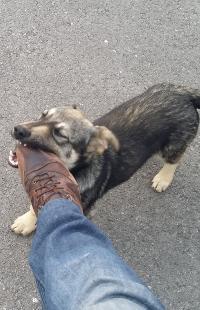Need guidance on E-stop/Disconnect Switch connections
- Sray69
- Offline
- Elite Member
-

- Posts: 255
- Thank you received: 13
I am in the process of drawing up an electrical diagram so I understand all the components needed and how they are connected. I am confused on the E-stops and Disconnect Switch I need as well as how to connect them.
I will be running LinuxCNC with a Mesa 7i76e, DM860T drivers and Nema 24s. I have a 6V/1200W/20A PS for the drivers/drives and a 24V/60W/2.5A PS for the Mesa.
I have read the following comments:
"most estop buttons (well the ones I bought anyway) have two contacts. One is normally closed and the other is normally open.
Wire the mains power to your motors through the NC side and wire field power through the NO side. So when you push the button it cuts the mains power and lights up a Mesa input to tell Linuxcnc estop has been pressed."
"emergency stop cuts motor input power and activates the disable inputs on the stepper drivers. (Note the DC power for activating those inputs must not have its power cut though - the way those disable inputs work on stepper drivers are a bit weird, they should require activation to enable the driver instead!). You probably want to cut the AC side of the motor power supply; DC will require a much beefier relay/contactor not to arc. If you do cut the DC side, pay close attention to the DC ratings of the relay/contactor."
from this post:
www.forum.linuxcnc.org/38-general-linuxc...-card-7i76e?start=20
I am not 100% sure I understand these comments. The drawing the OP did in that post was somewhat helpful for the E-stop but when I brought this up in another forum I walked away confused again. Can someone explain the easiest and best way (in laymen's terms) to hook up E-stops and a Disconnect Switch? An example drawing/diagram (if someone has one) would be a great help as I am trying to learn all the electrical terms still.
Please Log in or Create an account to join the conversation.
- rodw
-

- Offline
- Platinum Member
-

- Posts: 11509
- Thank you received: 3858
For a small personal machine at home, you can stop motion by dropping the AC power to the stepper power supply with one side of an estop button.
Then take +24v field power to the estop button and the other side to a 7i76e input. So when you disable all motion, you also tell linuxcnc about it.
In the hal examples section of the forum there is an example external estop config using the estop-latch component. This is the correct way but a lot will tell you other things...
This is not standards compliant as its not safe on larger machines to allow a machine to coast to a stop and for spindles to fall to the table. Brakes need to be applied, motion needs to be disabled in a powered up state. Maybe even a timer relay needs to be invoked to power off parts of the machine after it stops. On such machines, the safety circuit is external to linuxcnc and the wiring becomes a lot more complex. Estop buttons for a safety relay typically have two NC switch poles to provide redundancy and avoid a single point of failure. A signal is sent to linuxcnc when they are triggered. With these machines, usually there is an external momentary estop reset button that enables the safety relay/circuit but it can be in the gui. Any additional relays in the safety circuit should then be special force guided relays where the contacts are forced apart on activation to prevent the chance of contacts welding together. Usually 2 relays are used to add redundancy...
Please Log in or Create an account to join the conversation.
- Sray69
- Offline
- Elite Member
-

- Posts: 255
- Thank you received: 13
Anyway....
E-stops
So here are two example diagrams showing different ways to possibly implement an E-stop safety circuit. The first diagram is my interpretation of the drawing (page 2) that the OP of the post I linked to (fixed link) above. He admittedly made a mistake but did not correct the drawing. I corrected the mistake as I understood it. I would like to know thoughts on this setup? If it would not work, how can it be fixed to work, and how?
drive.google.com/file/d/15e6d8gqNQxh8J7Y...3e0/view?usp=sharing
The second diagram is from PrintNC. It is a more complex solution. I have been told:
But since I am getting conflicting info from various sources I thought I would throw it out there and see what the LinuxCNC group says. This design seems more complicated and needs more components but would like to know if this is a good option or not. What changes would I need to make to make it work for my setup?you don't need a Magnetic Contactor for your low 120v AC system, a simple SSR (solid state Relay) is all you need this will do the same as a Contactor
drive.google.com/file/d/1z21WyXEv93P2r_9...v5q/view?usp=sharing
Rod, I don't think either of these diagrams represent what you explained above. I would really like to see an example drawing/diagram and example of the components I would need to use. With all the confusion and conflicting info it is really hard for someone that is not very experienced in electronics to know exactly what is being said at times. Visuals are a huge help.
Disconnects
The PrintNC diagram also shows a Latching Safety Switch for the high voltage Master Power On/Off switch. The following is a snippit from the PrintNC wiki explaining the difference between a Latching Safety Switch and a E-stop. drive.google.com/file/d/1nBvAKWOdkUdNSrR...KpJ/view?usp=sharing
Based on my understanding of what a Disconnect Switch does (to turn the Power ON /OFF to your cabinet) it sounds very much like the Latching Safety Switch shown in the PrintNC diagram. In the explanation of the Latching Safety Switch it says:
Now when I asked in another forum whether I can use a Latching Safety Switch as the Disconnect Switch, because I like the idea of the added protection of from power disruptions, I was told:this may be used as your “master power on/off”. Think of it as energizing the shop at the start of the day and making sure power is off to everything in the PrintNC world at the end of the day.
Question: Is a contactor required for the magnetic function to work in the Latching Safety Switch? Or is the Contactor used in the low voltage E-stop circuit? The comment was a little confusing to me.you can't use a contactor as / for your cabinet disconnect. The disconnect is only to turn the Power 0N /0FF to your cabinet / Machine, in your case it can be just a simple switch. Your system is very simple, you have 2 Power supplies some Stepper Drives a Breakout Board and this is about it so don't complicate things for yourself.
I appreciate any and all guidance. I am doing my best to learn it but so many different opinions/ideologies/systems it makes it difficult at times to find a clear path.
Thanks!
Please Log in or Create an account to join the conversation.
- arvidb
-

- Offline
- Platinum Member
-

- Posts: 459
- Thank you received: 157
Often this means simultaneously cutting power to the motor drives and making sure the controller (LinuxCNC in this case) signals full stop to the drives. This ensures that the motors stop immediately (if the controller is still alive and in control) and that even if the controller is dead or can no longer control the drives for some reason, the motors will stop rather quickly. So typically the e-stop would cut power to the drives but not to the control circuit.
A disconnect as I understand it is a manual switch (often with a lock of some kind to prevent it from being mistakenly turned on) that will cut power to everything in the cabinet. Useful if your cabinet is permanently wired to the mains (not via a plug & wall socket) and you need to service the cabinet.
Please Log in or Create an account to join the conversation.
- tommylight
-

- Away
- Moderator
-

- Posts: 20950
- Thank you received: 7137
DC servo systems require proper e-stop implementation coupled with another set of "extreme" limit switches on each side of the axis, and wired to the e-stop chain to cut all power to the machine.
AC servo and stepper systems do not require such drastic measures.
All this has to do with how those systems fail:
-DC servo or brushed motors will run at full speed in the event of a transistor/mosfet shorts.
-AC and stepper systems will not move if transistors short, the motor stays locked drawing to much power so the fuses blow.
--
Cheap DC drives require also a braking resistor with a relay to prevent back EMF when switched off abruptly. Gecko drives had a nice schematic for this.
Please Log in or Create an account to join the conversation.
- rodw
-

- Offline
- Platinum Member
-

- Posts: 11509
- Thank you received: 3858
This is usually managed via a safety relay. This adds a lot of complexity to your wiring becaue every part of the system needs to have redundancy (via two seperate cicuits, switches, relays.) Safety relays generally require an estop reset button to be pressed to restore power to the motion parts.
Safety relays are required for compliance for commercially machines but rarely used on machines for home use.
Its dangerous to just accept a circuit diagram created for another cnc system. Many of them are just wrong (including ones shared on this thread)
Safety relays are expensive. The ones I used were $250 each and need a further two force guided relays which added close to another $100 to the system. It did my head in to workout how to wire one in. In such a wiring system, Linuxcnc has no involvement with estop other than that it is told when the estop reset is pressed and the estop button is pressed via a single input.
Please Log in or Create an account to join the conversation.
- tommylight
-

- Away
- Moderator
-

- Posts: 20950
- Thank you received: 7137
Just connect the e-stop to mesa.
Just wire the drive enable properly.
No switching, no shutting power, nothing.
--
For the rest, stop confusing the poor guy, we are not launching nuclear missiles here.
Please Log in or Create an account to join the conversation.
- Sray69
- Offline
- Elite Member
-

- Posts: 255
- Thank you received: 13
That sounds like exactly what I have been wanting to do, but I am having trouble determining the correct way to hook them up. I thought there would be an easy solution for this but apparently there isn't. I was hoping someone could guide me through it (in laymen's terms).Just connect the e-stop to mesa.
Just wire the drive enable properly.
No switching, no shutting power, nothing.
--
For the rest, stop confusing the poor guy, we are not launching nuclear missiles here.
Please Log in or Create an account to join the conversation.
- Sray69
- Offline
- Elite Member
-

- Posts: 255
- Thank you received: 13
Let me know what you think of this drawing. I came up with this iteration from another diagram I drew up that included a relay. I just removed the relay and rewired the E-stop.
I have 24V field power going through the NC side to a digital input. I am thinking this could work if I invert the state in HAL to "NOT". Does that sound right?
Also I fed the drivers using the 5V/GND from the unused stepgen on the Mesa. I ran the 5V through the NO side of the E-stop.
I would appreciate any help correcting my drawing.
drive.google.com/file/d/1n7JjQKnKvbeVyd4...j1N/view?usp=sharing
Please Log in or Create an account to join the conversation.
- tommylight
-

- Away
- Moderator
-

- Posts: 20950
- Thank you received: 7137
Please Log in or Create an account to join the conversation.
